+ Open data
Open data
- Basic information
Basic information
| Entry | Database: PDB / ID: 6fix | ||||||||||||
|---|---|---|---|---|---|---|---|---|---|---|---|---|---|
| Title | antitoxin GraA in complex with its operator | ||||||||||||
 Components Components |
| ||||||||||||
 Keywords Keywords | ANTITOXIN / GraA / HigA / operator / DNA / GraT / HigB | ||||||||||||
| Function / homology |  Function and homology information Function and homology information | ||||||||||||
| Biological species |  Pseudomonas putida (bacteria) Pseudomonas putida (bacteria) | ||||||||||||
| Method |  X-RAY DIFFRACTION / X-RAY DIFFRACTION /  SYNCHROTRON / SYNCHROTRON /  MOLECULAR REPLACEMENT / Resolution: 3.8 Å MOLECULAR REPLACEMENT / Resolution: 3.8 Å | ||||||||||||
 Authors Authors | Talavera, A. / Loris, R. | ||||||||||||
| Funding support |  Belgium, 3items Belgium, 3items
| ||||||||||||
 Citation Citation |  Journal: Nat Commun / Year: 2019 Journal: Nat Commun / Year: 2019Title: A dual role in regulation and toxicity for the disordered N-terminus of the toxin GraT. Authors: Ariel Talavera / Hedvig Tamman / Andres Ainelo / Albert Konijnenberg / San Hadži / Frank Sobott / Abel Garcia-Pino / Rita Hõrak / Remy Loris /     Abstract: Bacterial toxin-antitoxin (TA) modules are tightly regulated to maintain growth in favorable conditions or growth arrest during stress. A typical regulatory strategy involves the antitoxin binding ...Bacterial toxin-antitoxin (TA) modules are tightly regulated to maintain growth in favorable conditions or growth arrest during stress. A typical regulatory strategy involves the antitoxin binding and repressing its own promoter while the toxin often acts as a co-repressor. Here we show that Pseudomonas putida graTA-encoded antitoxin GraA and toxin GraT differ from other TA proteins in the sense that not the antitoxin but the toxin possesses a flexible region. GraA auto-represses the graTA promoter: two GraA dimers bind cooperatively at opposite sides of the operator sequence. Contrary to other TA modules, GraT is a de-repressor of the graTA promoter as its N-terminal disordered segment prevents the binding of the GraTA complex to the operator. Removal of this region restores operator binding and abrogates Gr aT toxicity. GraTA represents a TA module where a flexible region in the toxin rather than in the antitoxin controls operon expression and toxin activity. #1: Journal: Acta Crystallogr F Struct Biol Commun / Year: 2017 Title: Production, biophysical characterization and crystallization of Pseudomonas putida GraA and its complexes with GraT and the graTA operator. Authors: Talavera, A. / Tamman, H. / Ainelo, A. / Hadaei, S. / Garcia-Pino, A. / Horak, R. / Konijnenberg, A. / Loris, R. | ||||||||||||
| History |
|
- Structure visualization
Structure visualization
| Structure viewer | Molecule:  Molmil Molmil Jmol/JSmol Jmol/JSmol |
|---|
- Downloads & links
Downloads & links
- Download
Download
| PDBx/mmCIF format |  6fix.cif.gz 6fix.cif.gz | 220.1 KB | Display |  PDBx/mmCIF format PDBx/mmCIF format |
|---|---|---|---|---|
| PDB format |  pdb6fix.ent.gz pdb6fix.ent.gz | 178.4 KB | Display |  PDB format PDB format |
| PDBx/mmJSON format |  6fix.json.gz 6fix.json.gz | Tree view |  PDBx/mmJSON format PDBx/mmJSON format | |
| Others |  Other downloads Other downloads |
-Validation report
| Summary document |  6fix_validation.pdf.gz 6fix_validation.pdf.gz | 464.6 KB | Display |  wwPDB validaton report wwPDB validaton report |
|---|---|---|---|---|
| Full document |  6fix_full_validation.pdf.gz 6fix_full_validation.pdf.gz | 470.8 KB | Display | |
| Data in XML |  6fix_validation.xml.gz 6fix_validation.xml.gz | 17.1 KB | Display | |
| Data in CIF |  6fix_validation.cif.gz 6fix_validation.cif.gz | 22.9 KB | Display | |
| Arichive directory |  https://data.pdbj.org/pub/pdb/validation_reports/fi/6fix https://data.pdbj.org/pub/pdb/validation_reports/fi/6fix ftp://data.pdbj.org/pub/pdb/validation_reports/fi/6fix ftp://data.pdbj.org/pub/pdb/validation_reports/fi/6fix | HTTPS FTP |
-Related structure data
- Links
Links
- Assembly
Assembly
| Deposited unit | 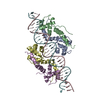
| ||||||||
|---|---|---|---|---|---|---|---|---|---|
| 1 |
| ||||||||
| Unit cell |
|
- Components
Components
| #1: Protein | Mass: 11746.399 Da / Num. of mol.: 4 Source method: isolated from a genetically manipulated source Source: (gene. exp.)  Pseudomonas putida (bacteria) / Gene: AYO08_18510 / Production host: Pseudomonas putida (bacteria) / Gene: AYO08_18510 / Production host:  #2: DNA chain | | Mass: 9512.188 Da / Num. of mol.: 1 / Source method: obtained synthetically / Source: (synth.)  Pseudomonas putida (bacteria) Pseudomonas putida (bacteria)#3: DNA chain | | Mass: 9217.960 Da / Num. of mol.: 1 / Source method: obtained synthetically / Source: (synth.)  Pseudomonas putida (bacteria) Pseudomonas putida (bacteria) |
|---|
-Experimental details
-Experiment
| Experiment | Method:  X-RAY DIFFRACTION / Number of used crystals: 1 X-RAY DIFFRACTION / Number of used crystals: 1 |
|---|
- Sample preparation
Sample preparation
| Crystal | Density Matthews: 7.33 Å3/Da |
|---|---|
| Crystal grow | Temperature: 293 K / Method: vapor diffusion, sitting drop Details: 0.2 M lithium sulfate, 0.1 M sodium acetate pH 4.5, 50% PEG 400 |
-Data collection
| Diffraction | Mean temperature: 90 K |
|---|---|
| Diffraction source | Source:  SYNCHROTRON / Site: SYNCHROTRON / Site:  SOLEIL SOLEIL  / Beamline: PROXIMA 2 / Wavelength: 0.979 Å / Beamline: PROXIMA 2 / Wavelength: 0.979 Å |
| Detector | Type: DECTRIS EIGER X 16M / Detector: PIXEL / Date: Apr 29, 2015 |
| Radiation | Protocol: SINGLE WAVELENGTH / Monochromatic (M) / Laue (L): M / Scattering type: x-ray |
| Radiation wavelength | Wavelength: 0.979 Å / Relative weight: 1 |
| Reflection | Resolution: 3.793→43.853 Å / Num. obs: 18427 / % possible obs: 99.54 % / Redundancy: 5.2 % / Rmerge(I) obs: 0.1271 / Net I/σ(I): 8.84 |
| Reflection shell | Resolution: 3.793→3.929 Å / Redundancy: 5.1 % / Rmerge(I) obs: 1.692 / Mean I/σ(I) obs: 0.91 / Num. unique obs: 1797 / CC1/2: 0.39 / % possible all: 95.69 |
- Processing
Processing
| Software |
| ||||||||||||||||||||||||||||||||||||||||||||||||||||||||
|---|---|---|---|---|---|---|---|---|---|---|---|---|---|---|---|---|---|---|---|---|---|---|---|---|---|---|---|---|---|---|---|---|---|---|---|---|---|---|---|---|---|---|---|---|---|---|---|---|---|---|---|---|---|---|---|---|---|
| Refinement | Method to determine structure:  MOLECULAR REPLACEMENT / Resolution: 3.8→43.853 Å / SU ML: 0.74 / Cross valid method: FREE R-VALUE / σ(F): 1.92 / Phase error: 38.6 MOLECULAR REPLACEMENT / Resolution: 3.8→43.853 Å / SU ML: 0.74 / Cross valid method: FREE R-VALUE / σ(F): 1.92 / Phase error: 38.6
| ||||||||||||||||||||||||||||||||||||||||||||||||||||||||
| Solvent computation | Shrinkage radii: 0.9 Å / VDW probe radii: 1.11 Å | ||||||||||||||||||||||||||||||||||||||||||||||||||||||||
| Refinement step | Cycle: LAST / Resolution: 3.8→43.853 Å
| ||||||||||||||||||||||||||||||||||||||||||||||||||||||||
| Refine LS restraints |
| ||||||||||||||||||||||||||||||||||||||||||||||||||||||||
| LS refinement shell |
| ||||||||||||||||||||||||||||||||||||||||||||||||||||||||
| Refinement TLS params. | Method: refined / Origin x: 119.1349 Å / Origin y: 7.5571 Å / Origin z: -4.1854 Å
| ||||||||||||||||||||||||||||||||||||||||||||||||||||||||
| Refinement TLS group | Selection details: all |
 Movie
Movie Controller
Controller






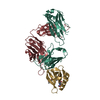

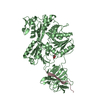

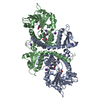
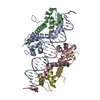
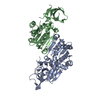

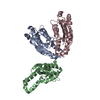
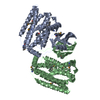
 PDBj
PDBj







































